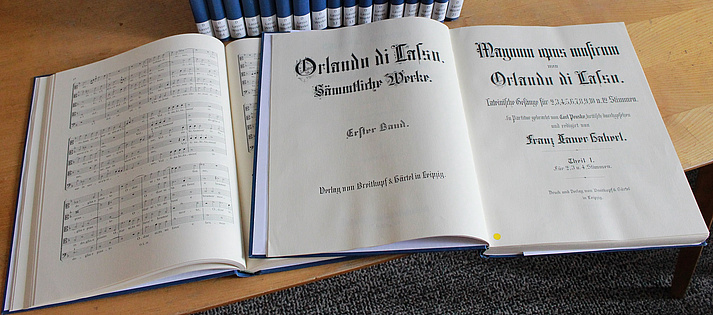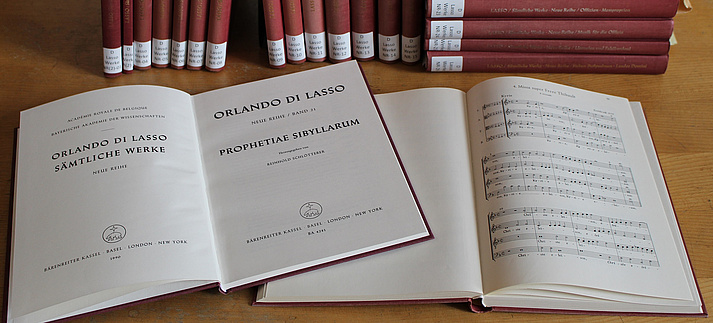Orlande de Lassus Complete Edition
The Orlande de Lassus Complete Edition (Orlando di Lasso-Gesamtausgabe) was a project of the advisory board of the „Orlando di Lasso-Ausgabe“ (previously Musikhistorische Kommission) with the Bavarian Academy of Sciences and Humanities.
The edition as a project of the Academy was preceded though by today’s so-called Old Complete Edition (heute sogenannte Alte Gesamtausgabe) which had not been supervised by the Academy.
The today so-called Old Complete Edition
The today so-called Old Complete Edition (Alte Gesamtausgabe) was developed in the years between 1894 and 1927 and was published by Breitkopf & Härtel in Leipzig. Its 21 volumes include almost all of the composer’s motets, madrigals, chansons and German songs, edited by Franz Xaver Haberl and Adolf Sandberger – almost half of Lassus’ complete works. This edition came to a standstill based on financial problems in economically difficult times. A list of the volumes can be found under Old Complete Edition (cf. also below with the Old Complete Edition revised in accordance with the sources).

The New Series
The New Series was initiated and supervised by the Bavarian Academy of Sciences and Humanities. The edition (26 volumes) was published with Bärenreiter in Kassel between 1956 and 1995, as a kind of supplement including everything missing in the Old Complete Edition, thus the masses (which cannot be unequivocally attributed as a whole to Lassus) and Magnificat, the passions, hymns, significant cycles such as the Lagrime di San Pietro and the Prophetiae Sibyllarum, the Penitential Psalms, Lectiones, Lamentationes, smaller liturgical works and finally a volume including motets, chansons and madrigals unknown to the editors of the Old Complete Edition, only to be found later within the scope of a comprehensive research of sources. Hence, with the exception of some dubia, all of Lassus’ works are present in the Complete Edition. A list of volumes can be found under New Series (Neue Reihe).

The New Series (Neue Reihe) is based on all printed and on significant manuscript resource material. Each volume provides an introduction to the works included, the editing guidelines, a directory and a description of the sources, a critical report and also a section with illustrations. Therefore, the New Series meets the requirements of a modern critical complete edition. Since it had been necessary to change the publisher (replacing Breitkopf & Härtel with Bärenreiter), the New Series is published in a different format than the Old Complete Edition. Also, the editing guidelines had to undergo some changes.
Second Printing of the Old Complete Edition Revised in Accordance with the Sources
Since for editing the works published in the Old Complete Edition only one single (and not the best) source was used, the Academy developed a Second Printing of the Old Complete Edition Revised in Accordance with the Sources together with the original publisher Breitkopf & Härtel, which was published between 1968 and 2022. It includes all of Lassus’ works already published in the Old Complete Edition, furthermore differing variants or edits plus setting overlooked so far, or settings not to be unequivocally attributed to Lassus, are printed in appendices.

For the new printing, just as for the New Series, all of the printed source material as well as significant manuscripts are being used. Comprehensive introductions address the works included as well as their history of transmission. Indices of sources inform on the material used. Instead of source descriptions it is referred to relevant literature, in parts not available yet to the editors of the New Series. Comprehensive critical reports, preceded by the editing guidelines, list errors, variants, new textings etc.
Printed are the texts set to music by Lassus; the illustrations in the facsimile section are mostly chosen in order to illustrate variants or editorial problems. The volumes conclude with a directory of the pieces included, many of them with bibliographies. Since the second edition extends well beyond a revision, including substantial deviations from the first printing regarding the music as well as so far unknown text versions, the Second Printing of the Old Complete Edition Revised in Accordance with the Sources basically represents a new edition.
Incorporating the introductory texts of the first printing in facsimile form though makes for the character of a revision, yet the introductory texts are brought up to date by comments. Furthermore, the new edition follows the score display of the first printing: It adopts the changes of pages and accolades. In accordance with an edition close to the sources, the old clefs used in the Old Complete Edition are also being maintained. As a whole though, the editing guidelines reach far beyond the ones applied in the first printing. A list of all volumes published can be found under Second Printing of the Old Complete Edition Revised in Accordance with the Sources.
Excerpts from reviews can be found here.
